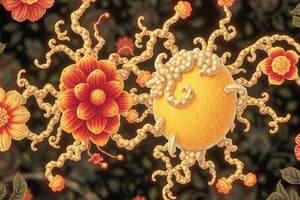Podcast
Questions and Answers
What is the role of HMG-CoA reductase in cholesterol biosynthesis?
What is the role of HMG-CoA reductase in cholesterol biosynthesis?
What is formed when six isoprene units polymerize in the cholesterol synthesis pathway?
What is formed when six isoprene units polymerize in the cholesterol synthesis pathway?
Which of the following processes requires ATP during the formation of oxaloacetate from citrate in the malate-aspartate shuttle?
Which of the following processes requires ATP during the formation of oxaloacetate from citrate in the malate-aspartate shuttle?
What role does the enzyme HMG-CoA reductase play in cholesterol biosynthesis?
What role does the enzyme HMG-CoA reductase play in cholesterol biosynthesis?
Signup and view all the answers
What is the immediate product formed after the cyclization of squalene in cholesterol biosynthesis?
What is the immediate product formed after the cyclization of squalene in cholesterol biosynthesis?
Signup and view all the answers
In which state is cholesterol biosynthesis most active?
In which state is cholesterol biosynthesis most active?
Signup and view all the answers
Which enzyme is primarily responsible for the condensation of three acetates to form mevalonate?
Which enzyme is primarily responsible for the condensation of three acetates to form mevalonate?
Signup and view all the answers
What is the primary effect of AMP-dependent protein kinase on HMG-CoA reductase?
What is the primary effect of AMP-dependent protein kinase on HMG-CoA reductase?
Signup and view all the answers
What is the role of the esterification of cholesterol?
What is the role of the esterification of cholesterol?
Signup and view all the answers
How many ATP molecules are required in total during the first two steps of cholesterol biosynthesis?
How many ATP molecules are required in total during the first two steps of cholesterol biosynthesis?
Signup and view all the answers
Flashcards
ATP requirement for malate-aspartate shuttle
ATP requirement for malate-aspartate shuttle
One ATP is needed to transfer citrate to oxaloacetate in the cytosol during the malate-aspartate shuttle, facilitating Acetyl-CoA release.
Malate-aspartate shuttle
Malate-aspartate shuttle
A process that regenerates oxaloacetate through malate transport across the mitochondrial membrane, facilitating its reuse in the citric acid cycle.
Mevalonate formation
Mevalonate formation
Three acetyl-CoA molecules combine to form mevalonate; 2 ATPs are consumed per mevalonate formed.
HMG-CoA reductase
HMG-CoA reductase
Signup and view all the flashcards
Pyruvate transporter
Pyruvate transporter
Signup and view all the flashcards
Cholesterol Esterification
Cholesterol Esterification
Signup and view all the flashcards
VLDL Transport
VLDL Transport
Signup and view all the flashcards
HMG-CoA Reductase Regulation - Short Term
HMG-CoA Reductase Regulation - Short Term
Signup and view all the flashcards
HMG-CoA Reductase Regulation - Long Term
HMG-CoA Reductase Regulation - Long Term
Signup and view all the flashcards
Energy Rich State & Cholesterol
Energy Rich State & Cholesterol
Signup and view all the flashcards
Study Notes
Biological Functions of Lipids
- Energy storage
- Membrane constituents
- Anchors for membrane proteins
- Enzyme cofactors
- Signaling molecules
- Pigments
- Detergents
- Transporters
- Antioxidants
Lipoproteins
- Lipids are transported as lipoproteins to be transported in water-filled environments (like blood and bodily fluids)
- Lipoproteins are macromolecular complexes
- Their core contains cholesterol, TAGs, and cholesteryl esters
- The core is coated with apolipoproteins and phospholipids
Classes of Lipoprotein Particles
- Classified by their density (determined by sedimentation in centrifuges)
- Classes differ in composition
- Transport fat-soluble vitamins (like vitamins A and E)
Major Classes of Human Plasma Lipoproteins (Table 21-1)
- Chylomicrons: Density < 1.006 g/mL; Composition: 2% protein, 9% phospholipids, 1% free cholesterol, 3% cholesteryl esters, 85% triacylglycerols
- VLDL: Density 0.95-1.006 g/mL; Composition: 10% protein, 18% phospholipids, 7% free cholesterol, 12% cholesteryl esters, 50% triacylglycerols
- LDL: Density 1.006-1.063 g/mL; Composition: 23% protein, 20% phospholipids, 8% free cholesterol, 37% cholesteryl esters, 10% triacylglycerols
- HDL: Density 1.063-1.210 g/mL; Composition: 55% protein, 24% phospholipids, 2% free cholesterol, 15% cholesteryl esters, 4% triacylglycerols
Apolipoproteins (Table 21-2)
- Proteins in lipoproteins
- Ensure transport of lipids between organs
- Serve as ligands for receptors
- Activate/inactivate lipoprotein lipase
- Some embedded in the particle surface (determining interaction with receptors)
- Others only loosely bound (exchanged between classes)
Biological Role of Lipoproteins in Trafficking Cholesterol and TAGs
- Exogenous pathway: Transports dietary lipids from intestines to the liver
- Endogenous pathway: Transports lipids synthesized in the liver to the periphery
- Reverse cholesterol pathway: Transports excess cholesterol from periphery back to the liver
- Chylomicrons: Play a role in the exogenous pathway and quickly leave the bloodstream
- VLDL: Part of the endogenous pathway, carrying TAGs and cholesterol to tissues. Also can become LDL remnants
Endogenous Pathway (Very Low Density Lipoproteins)
- Body takes in more cholesterol and fatty acids than needed for energy
- TAGs made from those extra nutrients and packed into VLDL
- VLDL circulate, releasing TAGs in tissues (like muscle, heart, adipose)
- VLDL shrinks to become IDL (intermediate density lipoproteins)
- IDL continue to shrink and become LDL, carrying cholesterol to tissues
Receptor-Mediated Endocytosis of LDL
- Cells take up LDL via LDL receptors
- LDL receptors bind to ApoB-100 on LDL
- LDL is internalized into endosomes
- Lysosomes mix with the endosome and break down the LDL, releasing cholesterol
High Density Lipoproteins (HDL)
- HDLs originate in the liver and small intestine (nascent HDL)
- Nascent HDL can pick up cholesterol from peripheral cells via ApoA-1 activating the ABCA1 transporter
- The enzyme LCAT (lecithin:cholesterol acyltransferase) esterifies cholesterol (turning it from a water soluble to a fat soluble molecule).
- Mature HDL then transports cholesteryl esters to the liver (via the liver's scavenger receptor B1 protein, SR-B1)
Studying That Suits You
Use AI to generate personalized quizzes and flashcards to suit your learning preferences.
Related Documents
Description
Explore the essential roles of lipids in energy storage, membrane structure, and cellular signaling. This quiz covers the composition and classification of lipoproteins, including key differences among major classes. Test your understanding of how lipids function and their importance in human health.




